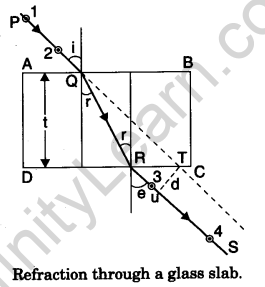Table of Contents
To observe refraction and lateral deviation of a beam of light incident obliquely on a glass slab
Aim – To observe refraction and lateral deviation of a beam of light incident obliquely on a glass slab.
Apparatus
Glass slab, drawing board, white paper sheet, drawing pins, office pins, protractor.
Theory
When a ray of light (PQ) incident on the face AB of glass slab, then it bends towards the normal since refraction takes place from rarer to denser medium. The refracted ray (QR) travel along straight line and incident on face DC of slab and bends away from the normal since refraction takes place from denser to rarer medium. The ray (RS) out through face DC is called emergent ray.
From the following diagram
- The incident ray is parallel to the emergent ray i.e. i = e.
- The emergent ray is laterally deviated from its original path (incident ray) by a distance d = t sec r sin (i – r).
Click Here: CBSE Syllabus For Class 12
Diagram

Procedure
- Fix a white paper sheet by drawing pins on a drawing board.
- Take a glass slab and put it symmetrically in the middle of the paper and mark its boundary ABCD.
- Draw a normal at point Q on face AB and draw a line PQ making an angle i with the normal. PQ will represent an incident ray.
- Fix two pins at points 1 and 2 on the line PQ at distances 1 cm or more between themselves.
- See images of these pins through face DC and fix two more pins at points 3 and 4 (1 cm or more apart) such that these two pins cover the images of first two pins, all being along a straight line.
- Remove the glass slab. Draw straight line RS through points 3 and 4 to represent emergent ray. Join QR to represent refracted ray.
- Draw normal at point R on face DC and measure angle e. It comes to be equal to angle i. Produce PQ forward to cut DC at T. Draw TU perpendicular to RS. TU measures lateral displacement d.
- Now take another set for different angle of incident and measure the lateral displacement.

Conclusions
- Angle of incidence (i) = Angle of emergence (e).
- The lateral displacement increases with the increase in the thickness of the slab.
- The lateral displacement increases with the angle of incidence (i).
More Resources for Class 12
- NCERT Solutions for Class 12 Maths
- NCERT Solutions for Class 12 Physics
- NCERT Solutions for Class 12 Chemistry
- NCERT Solutions for Class 12 Biology
- NCERT Books
- NCERT Books for Class 12






